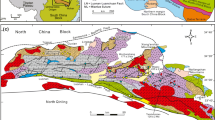Abstract.
The Jiaodong gold province, along the southeastern margin of the North China craton, has combined production and resources of >900 tonnes of gold. More than 95% of the gold in this province is hosted in Mesozoic granitoids, which intruded Late Archean metamorphic basement rocks episodically at ca. 160–150 and 130–126 Ma. The deposits of the Jiaodong Peninsula form one of the largest provinces of granitoid-hosted lode-gold deposits in the world. The Jiaodong gold deposits occur as massive auriferous quartz veins hosted in subsidiary second- or third-order faults, and as disseminated- and stockwork-style mineralization hosted in alteration zones along major regional-scale faults. Mineralization took place during brittle reactivation (D3) of pre-existing D2 ductile shear zones. Wall rock alteration is dominated by K-feldspar and sericite, with also sulfide minerals and extensive silicification closest to the orebodies. The alteration was accompanied by the introduction of volatiles, Fe, Mg, K, Rb, Ag, As, Au, Bi, and Sb. Enrichment of base metals in the gold lodes is generally low, although locally significant. Gold deposition took place at temperatures of 250 to 350 °C for most gold deposits, and the ore fluids are CO2-bearing and have calculated salinities of 6–13 wt% NaCl equiv. Deposits from the Zhao–Ye, Xixia, and Muping–Rushan belts have similar, if not identical, structural controls, alteration patterns, ore mineral assemblages, and stable isotope signatures. Lead isotope data indicate that the ore-stage leads were buffered by their host rocks. The granitoid-hosted gold deposits in the Zhao–Ye belt are most radiogenic, the greenstone-hosted deposits in the Xixia belt is the least radiogenic and the granitoid-hosted deposits in the Muping–Rushan belt have intermediate compositions. Gold mineralization in the Zhao–Ye, Xixia, and Muping–Rushan belts in the Jiaodong gold province appears to be broadly contemporaneously at ca. 130–120 Ma, as constrained by SHRIMP U–Pb zircon dating on host rocks and a post-gold dike, as well as by Ar–Ar, Rb–Sr, and K–Ar dating of hydrothermal alteration minerals and ores. This Early Cretaceous age is about 100 million years younger than the peak of ultra-high pressure metamorphism in the Qinling–Dabie–Sulu orogen between the North China and Yangtze cratons, and about 500 km south of the gold province. However, it overlaps with the extension and exhumation stage of the collisional orogeny, and the subduction of the Pacific plate beneath the Eurasian continental crust. Whereas the majority of the Jiaodong gold deposits occur on the margin of the North China craton, some also occur in the suture zone between the two cratons. They are significantly landward relative to the subduction zone of the Pacific Plate compared with typical orogenic lode-gold deposits globally. Lode-gold deposits of ca. 130–120 Ma occurred on both sides of the Tan-Lu fault zone. Available data favor a temporal link of gold mineralization with Pacific Plate subduction.
Similar content being viewed by others
Author information
Authors and Affiliations
Additional information
Electronic Publication
Rights and permissions
About this article
Cite this article
Qiu, Y., Groves, D.I., McNaughton, N.J. et al. Nature, age, and tectonic setting of granitoid-hosted, orogenic gold deposits of the Jiaodong Peninsula, eastern North China craton, China. Min Dep 37, 283–305 (2002). https://doi.org/10.1007/s00126-001-0238-3
Received:
Accepted:
Issue Date:
DOI: https://doi.org/10.1007/s00126-001-0238-3




